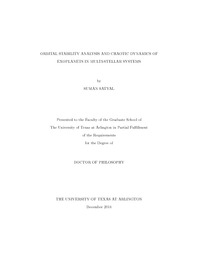
ATTENTION: The works hosted here are being migrated to a new repository that will consolidate resources, improve discoverability, and better show UTA's research impact on the global community. We will update authors as the migration progresses. Please see MavMatrix for more information.
Show simple item record
| dc.contributor.author | Satyal, Suman | en_US |
| dc.date.accessioned | 2015-07-01T17:50:20Z | |
| dc.date.available | 2015-07-01T17:50:20Z | |
| dc.date.issued | 2014-12 | |
| dc.date.submitted | January 2014 | en_US |
| dc.identifier.other | DISS-12865 | en_US |
| dc.identifier.uri | http://hdl.handle.net/10106/24907 | |
| dc.description.abstract | The advancement in detection technology has substantially increased the discovery rate of exoplanets in the last two decades. The confirmation of thousands of exoplanets orbiting the solar type stars has raised new astrophysical challenges, including the studies of orbital dynamics and long-term stability of such planets. Continuous orbital stability of the planet in stellar habitable zone is considered vital for life to develop. Hence, these studies furthers one self-evident aim of mankind to find an answer to the century old question: Are we alone?This dissertation investigates the planetary orbits in single and binary star systems. Within binaries, a planet could orbit either one or both stars as S-type or P-type, respectively. I have considered S-type planets in two binaries, $\gamma$ Cephei and HD 196885, and compute their orbits by using various numerical techniques to assess their periodic, quasi-periodic or chaotic nature. The Hill stability (HS) function, which measures the orbital perturbation induced by the nearby companion, is calculated for each system and then its efficacy as a new chaos indicator is tested against Maximum Lyapunov Exponents (MLE) and Mean Exponential Growth factor of Nearby Orbits (MEGNO). The dynamics of HD 196885 AB is further explored with an emphasis on the planet's higher orbital inclination relative to the binary plane. I have quantitatively mapped out the chaotic and quasi-periodic regions of the system's phase space, which indicates a likely regime of the planet's inclination. In, addition, the resonant angle is inspected to determine whether alternation between libration and circulation occurs as a consequence of Kozai oscillations, a probable mechanism that can drive the planetary orbit to a large inclination.The studies of planetary system in GJ 832 shows potential of hosting multiple planets in close orbits. The phase space of GJ 832c (inner planet) and the Earth-mass test planet(s) are analyzed for periodic-aperiodic orbits. The stability of the system is defined in terms of its \emph{lifetime} and maximum eccentricity during the integration period then a regime is established for the known and injected planet's orbital parameters. The de-stabilizing resonances due to the outer planet extend by 1.36 AU towards the star, nonetheless, existence of two Earth-mass planets seems plausible. The radial velocity (RV) curves generated for the test planets reveals a weak RV signal that cannot be measured by currently available instruments.A theory has been developed by extrapolating the radio emission processes in the Jupiter-Io system, which could reveal the presence of exomoons around the giant exoplanets. Based on this theory, maximum distance, radius and masses of exoplanets and exomoons are calculated that could be detected by the available radio telescopes. Observation time at the Low Frequency Array (LOFAR) radio telescope has been proposed to detect exomoon in five different stellar systems. Subjects of my future studies include analysis of the data from LOFAR, search for the additional transiting planets in Kepler 47 circumbinary system and observation at the Subaru telescope to verify the predicted planets in GJ 832 system by the method of direct imaging. | en_US |
| dc.description.sponsorship | Musielak, Zdzislaw | en_US |
| dc.language.iso | en | en_US |
| dc.publisher | Physics | en_US |
| dc.title | Orbital Stability Analysis And Chaotic Dynamics Of Exoplanets In Multi-stellar Systems | en_US |
| dc.type | Ph.D. | en_US |
| dc.contributor.committeeChair | Musielak, Zdzislaw | en_US |
| dc.degree.department | Physics | en_US |
| dc.degree.discipline | Physics | en_US |
| dc.degree.grantor | University of Texas at Arlington | en_US |
| dc.degree.level | doctoral | en_US |
| dc.degree.name | Ph.D. | en_US |
Files in this item
- Name:
- Satyal_uta_2502D_12865.pdf
- Size:
- 19.99Mb
- Format:
- PDF
This item appears in the following Collection(s)
Show simple item record


